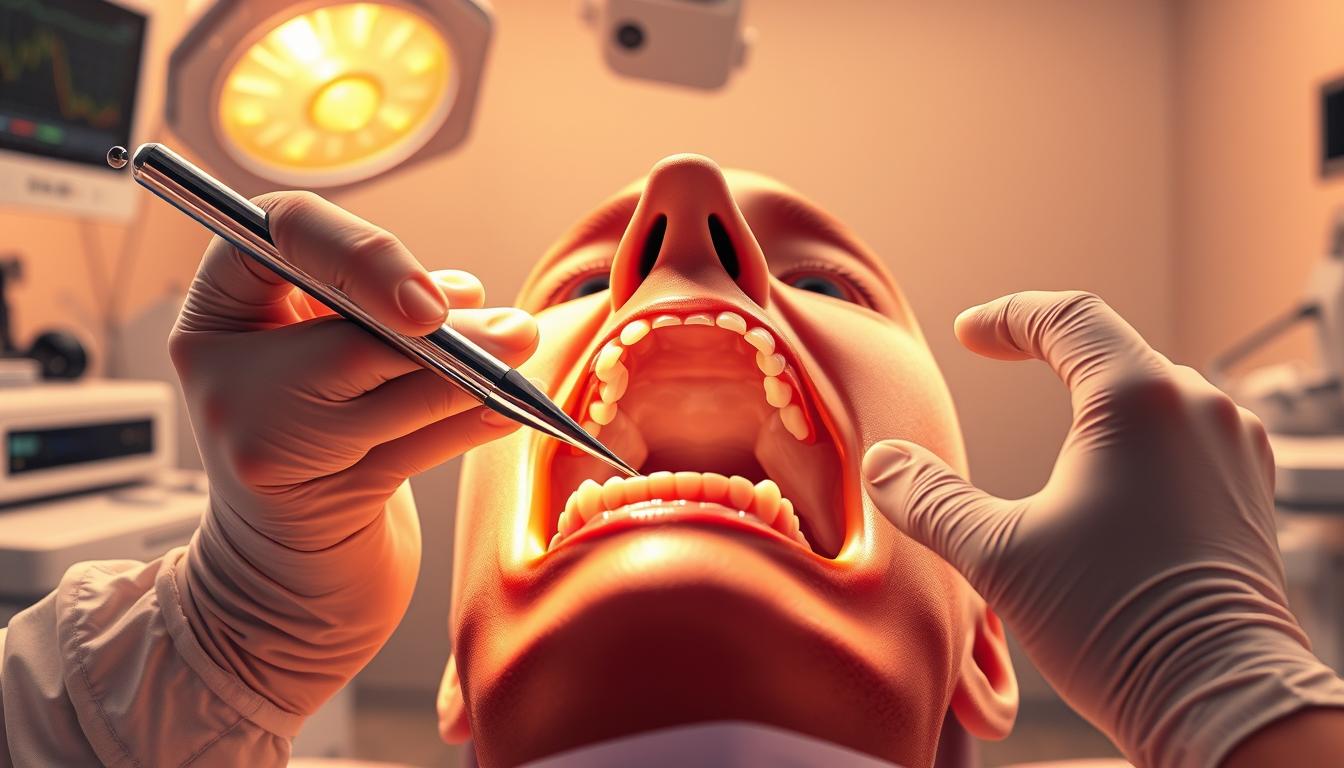Ever wondered why oral surgery seems scary, even though it can fix a smile? This guide will light up every step, offering tips to ease your worries.
Oral surgery includes many procedures inside the mouth or jaw. It ranges from tooth extractions to jaw realignments and dental implants. Thanks to modern tech, like 3D imaging, these surgeries are now faster and safer.
Check out our detailed guide to learn how to prepare, what to expect, and how to recover. Read this comprehensive overview to understand each step, from the first visit to the follow-up.

Key Takeaways
- Oral surgery involves procedures that target mouth or jaw issues.
- Preparation includes simple steps like soft-food planning and rest.
- The surgical team uses modern tools to enhance safety.
- Dental implants are a lasting solution for missing teeth.
- Recovery is smoother when you follow after-care instructions closely.
What Is Oral Surgery and When Is It Needed
Many dental problems need more than just cleanings or fillings. An oral surgeon is needed for issues with bones, soft tissues, and special procedures. Each patient’s needs are different, but the main goal is to improve function and comfort.

Definition and Scope of Oral Surgery
An oral surgeon is trained to treat mouth, jaw, and surrounding area problems. They do things like remove teeth, fix jaw issues, and do reconstructive work. They learn about detailed anatomy and how to use sedation to keep patients calm.
Common Reasons Patients Need Oral Surgery
People often need surgery for things like impacted wisdom teeth or severe tooth decay. Some have jaw problems, while others need soft tissue repair. Sometimes, complex tooth replacements require an oral surgeon’s skill for long-term success.
Diagnostic Process and Referrals
The journey to surgery often starts with a dentist’s thorough check-up. X-rays or scans might show hidden problems that need a specialist. If you have ongoing pain or jaw issues, you might need an oral surgeon. This resource helps you choose the best treatment for your needs.
Types of Oral Surgery Procedures Explained
Many treatments fall under dental oral surgery. These include removing teeth, fixing jaw alignment, or checking out growths. Each procedure has its own benefits and a careful plan for safety.

Simple and Surgical Tooth Extractions
Simple extractions are for teeth that are easy to see. The area is numbed, and the tooth is gently pulled out. Surgical extractions are more complex. They’re needed for teeth that are broken or hidden under the gum, requiring small cuts or bone work.
Wisdom Teeth Removal Techniques
Wisdom teeth often cause problems like tight spacing, pain, or infections. An oral surgeon may remove these teeth to protect others and prevent complications. Sometimes, part of the bone or gum needs to be removed, so following healing instructions is crucial.
Corrective Jaw Surgery (Orthognathic Surgery)
Misaligned jaws can make chewing, speaking, and facial looks off. Corrective jaw surgery moves the jaw to fix these issues. It can ease pain and improve facial balance. Surgeons use imaging to plan the surgery precisely.
Biopsies and Oral Pathology
Unusual lumps or lesions need a closer look. Biopsies take tissue samples to check if they’re benign or cancerous. Early diagnosis helps in treating them quickly and effectively. For more on these procedures, check out this resource.
Finding and Choosing a Qualified Oral Surgeon
Getting the right care is key when you’re planning oral surgery. A licensed expert with lots of experience makes you feel safe and confident. It’s smart to check their credentials, memberships, and training in complex surgeries.

Many specialists are certified by groups like the American Board of Oral and Maxillofacial Surgery. They know a lot about implants, jaw realignment, and more. Looking into these details shows they follow the best practices.
Credentials and Specializations to Look For
Surgeons who are up-to-date with the latest methods and technology usually get better results. Dentists who work in hospitals have more experience. Make sure they keep learning to show they care about their work.
Questions to Ask During Your Consultation
Talking to the surgeon in person is important. You can ask:
- What sedation techniques are available?
- How long is the anticipated recovery period?
- Which complications are most common for my condition?
- What follow-up arrangements are in place?
Reading Reviews and Getting Recommendations
Looking at reviews on healthcare sites or from friends can help. They share their experiences and opinions. Knowing how others feel can help you decide. Remember, quality and safety are more important than cost for your peace of mind.
Preparing for Your Oral Surgery Appointment
Getting ready for your surgery can make you feel more at ease. Choosing a skilled oral surgeon boosts your confidence. This is true whether you need a simple tooth extraction or something more complex.

Pre-Surgery Instructions and Restrictions
If you’re having IV sedation or general anesthesia, you might need to fast for hours. Always follow the instructions from your care team. Wear loose clothes and remove any jewelry that could get in the way.
What to Bring on Surgery Day
Make sure to arrive early with important documents. Here’s what you should bring:
- Photo ID and insurance information
- List of current medications
- Comfortable clothing and slip-on shoes
Setting Up Your Home for Recovery
Prepare soft foods, extra pillows, and any medication in advance. Create a quiet space for rest. If you’re under sedation, make sure you have a safe ride home.
Mental Preparation Strategies
Try deep breathing or guided visualization to calm your nerves. Knowing what to expect can also help. Your oral surgeon is a great source of information.
| Step | What to Do | Why It Helps |
|---|---|---|
| Fasting (if needed) | Avoid food and drink for 8 hours | Helps ensure safe sedation |
| Arrive Early | Give yourself extra time | Reduces pre-surgery stress |
| Secure Transportation | Ask a friend or family member | Ensures safe ride post-sedation |
The Oral Surgery Experience: What to Expect
Many patients feel better when they know what to expect. Understanding each step of the procedure boosts confidence. It gives a clear idea of what will happen during surgery.
Types of Anesthesia and Sedation Options
Anesthesia makes the procedure less painful. Local anesthesia numbs the area. IV sedation lets you rest but stay awake.
Learn more about preparing for IV sedation to get important tips before your surgery.
The Surgical Environment and Team
A clean and ready operating room is key. The team, including the surgeon and staff, work together for safety. They use modern tools for less damage and faster healing.
Step-by-Step Through a Typical Procedure
Preparation includes:
- Sanitizing the area
- Administering anesthesia
- Checking if you’re comfortable
The surgeon then uses special tools. Monitors watch your vital signs until it’s all done.
Duration and Immediate Aftermath
Procedure time varies. It can be quick or take longer. You’ll be watched as you recover.
Some might feel a bit swollen or sore. But, following aftercare tips helps you get back to normal fast.
Dental Implants: The Modern Tooth Replacement Solution
Many people struggle with gaps in their smile. Dental implants are a modern solution. They anchor a titanium post into the jawbone, creating a strong base for a crown. This allows for secure chewing and a natural look.
Studies show dental implants have a success rate of about 97% over the long term.
How They Function and Integrate
The titanium post fuses with the jawbone through a process called osseointegration. This keeps the bone healthy and prevents teeth from shifting.
The Complete Implant Procedure Timeline
The process starts with an evaluation and the placement of the implant. It then takes three to nine months for healing. After that, a custom crown is attached, lasting over 15 years.
Candidacy Requirements for Implants
Good candidates have healthy gums and enough jawbone. They also need to practice good oral hygiene. Smoking and some medical conditions might make you less eligible.
Benefits Compared to Bridges and Dentures
Dental implants don’t harm nearby teeth and don’t need adhesives. They feel like real teeth, boosting confidence. For more information, visit this resource.
Recovery After Oral Surgery: Day by Day Guide
Healing after surgery can seem tough, but with the right steps, it gets easier. Rest and taking care of your wound are key. A good guide is this recovery timeline with helpful tips for each day. Being patient and careful is crucial for getting back to normal, especially after dental surgery.
First 24 Hours Post-Surgery Care
Use gauze pads to stop bleeding early on. Light activities help save energy and avoid moving too much. Cold compresses on your cheek can help with swelling and feel soothing.
Managing Pain, Swelling, and Bleeding
Medicine, whether over-the-counter or prescribed, can help with pain. Swelling usually gets worse on the second day but goes down soon. To stop bleeding, apply steady pressure with clean gauze and avoid hard rinses.
Recommended Diet and Nutrition During Recovery
Eat soft foods to help your body heal. Think mashed potatoes, blended soups, and yogurt. Drinking plenty of water is important, but avoid using straws to prevent clotting. Cool drinks and gentle sips are best for sensitive areas.
Oral Hygiene During the Healing Process
Use saltwater rinses to clean your mouth gently. Brush softly, avoiding stitches and sore gums. Keeping up with oral hygiene daily helps prevent infection and keeps you calm during recovery.
Potential Complications and Risk Management
Feeling nervous about oral surgery is normal. But knowing about possible issues can make you feel better. Infections, like swelling or discharge, and dry socket are common worries.
Common Complications Following Surgery
Concerns like infections, bleeding, or nerve issues are common. Signs of trouble include intense pain or numbness. But, most bruising and swelling go away with time if you take care of yourself.
Warning Signs That Require Immediate Attention
Severe fever, constant pain, or trouble opening your mouth are red flags. Getting help quickly is key. Don’t hesitate to reach out to your doctor if you notice these symptoms.
Prevention Strategies for Optimal Healing
Being gentle with your mouth and following diet advice helps healing. Avoid smoking and alcohol to speed up recovery. People with chronic illnesses might need special care, including oral sedation.
When and How to Contact Your Surgeon
If you have bleeding, pain, or swelling that won’t go away, call your surgeon. Knowing how to reach them quickly is important. Early action can help you get back to normal faster.
Insurance Coverage and Financing for Oral Surgery
Planning for surgical costs can feel overwhelming. A clear strategy helps you stay informed and confident when coordinating with any oral surgeon. Open dialogue between you, the insurance provider, and your care team often leads to more manageable expenses.
“Research is a patient’s best ally when navigating insurance terms and plan details,” advises the American Dental Association.
Understanding Dental vs. Medical Insurance Coverage
Some oral procedures fall under dental benefits, while others may be classified as medical services. Accident-related treatments or jaw issues frequently qualify through medical plans, but coverage varies. Confirm categories early so that potential co-pays and deductibles are clear.
Pre-Authorization Requirements and Process
Insurers often need documentation that proves a procedure’s necessity. Pre-authorization includes submitting x-rays, referrals, and cost breakdowns. Gathering these records from your oral surgeon and sending them on time can reduce delays.
Payment Plans and Financing Options
Financing pathways help many patients budget for treatment. A helpful resource is the financing options page that outlines flexible plans. Providers such as Cherry, Lending Club, and Care Credit offer various solutions. The table below highlights key features:
| Provider | Key Features |
|---|---|
| Cherry | Easy pay-over-time structure with manageable monthly payments |
| Lending Club | Financing from 6 to 84 months and no retroactive interest |
| Care Credit | Healthcare credit card with promotional rates for eligible amounts |
Questions to Ask Your Insurance Provider
Verification of annual coverage limits, network discounts, and any co-payment changes can eliminate confusion. You may also want to inquire about claim timelines and any secondary insurance benefits that may further reduce cost. This dialogue supports clear, stress-free planning.
Advanced Technologies in Modern Oral Surgery
The world of oral care is changing fast, with new tools and methods. These advancements make procedures safer and more precise. Surgeons use digital tools to improve their work with each patient.
“The American Dental Association recognizes that digital tools enhance patient comfort and surgical precision.”
3D Imaging and Computer-Guided Approaches
Three-dimensional scans give a clear view of jaw structures. This helps place implants accurately and avoid problems. Computer navigation makes the surgical path even more precise.
Laser Applications in Oral Procedures
Laser treatments work on delicate tissues with less bleeding. This means patients might heal faster and feel more comfortable.
Minimally Invasive Surgical Techniques
Some surgeries use small incisions or special tools. This leads to less swelling and a quicker recovery. It’s great for those with busy lives.
Emerging Innovations in the Field
Robotic systems and regenerative therapies are on the horizon. They could change oral care for the better. Advances in materials and guided procedures promise a bright future.
Special Considerations for Different Patient Groups
Every patient needs a plan that fits their age, health, and future goals. Kids might need gentle sedation for their first dental visits. Talking openly with parents helps everyone feel more at ease.
People with ongoing health issues, like heart disease or diabetes, might need extra tests first. Dentists work with doctors to keep risks low. Older adults might choose dental implants for better eating. A bone density test shows if they’re a good fit for implants.
Women who are pregnant should talk to their doctor and dentist about when to get dental work. Procedures are usually done in the middle of pregnancy. This way, the mom’s health and the baby’s growth are both considered.
| Group | Key Focus |
|---|---|
| Pediatric Patients | Gentle sedation, child-friendly environment |
| Medical Conditions | Collaborative evaluations, minimized risks |
| Elderly Patients | Bone density checks, potential for dental implants |
| Pregnancy | Safe scheduling, consultation with OB-GYN |
Conclusion: Taking the Fear Out of Oral Surgery
Many people get nervous when they find out they need dental oral surgery. This fear often comes from not knowing what will happen. A research article shows that understanding the process can help reduce stress. Knowing about anesthesia, post-operative care, and how to prepare at home makes you feel more at ease.
Every person’s experience is different. Some worry about pain, while others fear complications. Skilled surgeons use the latest techniques to make procedures more predictable. Advances in imaging and sedation help reduce discomfort, boosting your confidence.
By talking openly with your care team and asking questions, you build trust. This conversation fills in knowledge gaps and makes you feel like your needs are important. Many find that once they start, their anxiety fades away.
Emotional support and thorough guidance help you feel ready for every step. Dental oral surgery can be a powerful step towards better health and a brighter smile. It leaves fear far behind.
FAQ
How do I know if I need oral surgery for my dental issue?
If you have ongoing pain, swelling, or teeth that move, you might need oral surgery. A licensed oral surgeon can check if you need surgery. They might use X-rays or 3D imaging to see if you have impacted teeth or jaw problems.
Are wisdom teeth extractions always necessary?
Not all wisdom teeth need to be removed. But, if they’re impacted or push other teeth, you might need surgery. An oral surgeon will look at your mouth and check images to decide if you need an extraction.
Can dental implants replace missing teeth effectively?
Yes, dental implants can replace missing teeth well. An oral surgeon puts a titanium post in your jaw and attaches a crown. This keeps your jawbone healthy and feels like your own teeth.
What types of sedation options are available during oral surgery?
Sedation options depend on your surgery and what you prefer. You might get local anesthesia, IV sedation, or general anesthesia. Your oral surgeon will pick the safest and most comfortable option for you.
How should I prepare for my dental oral surgery appointment?
Follow preoperative instructions carefully. If you’ll have IV or general anesthesia, you might need to fast. Wear comfy clothes, bring your medical history and insurance, and arrange a ride home. These steps make your experience smoother.
What can I expect in terms of recovery after oral surgery?
Recovery time varies based on your surgery. You’ll likely have swelling, discomfort, and some bleeding at first. Eating soft foods, staying hydrated, and following your surgeon’s advice helps you heal faster.
Does insurance typically cover oral surgery?
Insurance coverage varies. Check your policy to see if it covers dental or medical procedures. Many oral surgeons also offer payment plans or financing options.
What happens if complications arise after surgery?
If you have issues like infection or bleeding, contact your surgeon right away. They can help manage problems and ensure you heal properly.
Will my oral surgeon use advanced technology like 3D imaging?
Many oral surgeons use 3D imaging for precise planning. This technology gives clear views of your jaw and mouth. It’s useful for dental implants, jaw surgery, and complex extractions.
How do I choose the right oral surgeon for my procedure?
Look for a board-certified surgeon with experience in your procedure. Check their technology and read patient reviews. Ask about sedation, recovery, and risks during your consultation to find a trusted specialist.
